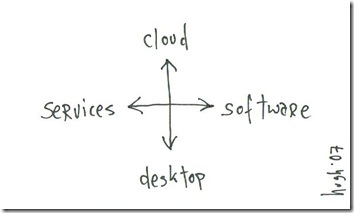On Cartoons #2: Software / Services. Desktop and centre

Hugh drew this, and Steve Clayton talks about it on his blog. I was going to post something about it here, but then I found myself saying something on an internal discussion (about when our Unified Communications offering competes with Cisco and when we co-operate). It was better than the post I had in mind, so I've adapted that here...
I have used the same theory for about 15 years and I’m not wiling to give it up yet. IT companies (I suppose I should say ICT) companies are either Primarily desktop or Primarily datacenter. Very rarely are they entirely one of these, but they can’t be equally both. Is the client there to exploit a great service ? Or is the service there to facilitate a great client ? Sometimes the best customer experience will take the client from one company and service from another and make them work together. Where competitors end up cooperating (so called Coopertition) it's driven by that demand from customers. The "big ticket" items are centre/infrastructure ones; "law of big numbers" items are the desktop/client ones. But for a lot of organizations, the desktop is where business happens.
When I started saying this in the 90’s IBM and Novell (say) were about the centre (being mainframe and server companies they couldn’t be anything else), and Microsoft, Word Perfect, Lotus were about the desktop. And after I the stuff I've said about phones and UC lately, I've never met a PBX vendor who said “We’re in the phones business – the PBX is just there to serve the phone” - so PBXs are the new mainframes and desktop phone has become an evolutionary dead end - no better at helping business to happen at the desktop than they were 20 years ago.
Of course the Internet has spawned a new kind of centre company -which doesn't deliver over a private network but provides "services in the cloud". Google - to name but one - are a “centre” company.
Microsoft is in the server business (big time), but at our core we are a desktop company (Windows client and Office). "Build back-end services to use the power of the PC" was as true for Exchange 4.0 as it is for Windows Live.
Now Steve says we want to be in the middle of this ... whilst I don't think anyone can be absolutely central, we don't have to be out at the extremes either. Look at X-box Live. A great service to enable a great client experience (and to my surprise the extra live bits on Xbox 360 have been the biggest difference from original Xbox). Look at Apple. No one could say that the iPod was built just be a client of the iTunes Music Store; it is a great client in its own right. Yet, for many users the store service maximizes what their device delivers. Even examples like writing a blog post ... It's far easier to use my PC to help with the process using Windows Live writer than it is to do compose in text box in a browser. There are some things which only need the software on the desktop and others which are almost entirely in the cloud (with the Browser in place of the VT220 terminal) - the outlying edges on Hugh's drawing, But the interesting ones - where we want to be - are towards the middle the combination of Good software on the desktop & Good Services in the cloud.